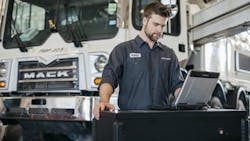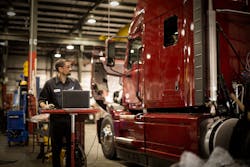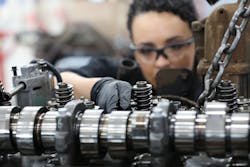In the early days of heavy-duty commercial trucks, fleets could choose from a fairly wide variety of options from different manufacturers to customize a vehicle that suited their needs. The truck could be fairly complex, but that complexity came in the form of mechanical components that most technicians could easily service.
Today’s commercial trucks are still available with a certain level of intricacy on a basic mechanical level, but it is the newer, more advanced technologies that have been developed over the past 10 to 15 years that makes these vehicles truly complex. Systems that fleets have come to rely on to make trucks safer, more operationally efficient, and more comfortable than ever are driven by complex electronics, sensors, and electronic control units (ECUs) utilizing miles of wiring.
“As the industry has evolved and grown, customers have become much more sophisticated in thinking about their vehicle as a business solution and are spec’ing their vehicles based on their specific application,” said Ryan Major, on highway marketing manager, Daimler Trucks North America.
Fleets are also spec’ing trucks with the driver shortage in mind, making them easier and more comfortable to operate with features such as advanced driver assistance systems (ADAS), automated manual transmissions (AMTs), and more complex infotainment systems.
“You've got computers for collision mitigation, roll over control, tractor-trailer combinations, ABS,” said Tim Bauer, vice president aftermarket North America, Eaton. “Then you've got ECUs that manage the engine-to-transmission coupling and transmission of power and the automatic shifting, so there's another ECU there.”
Service and maintenance considerations
As the complexity level of a vehicle increases, so too does the skill and knowledge necessary to maintain, diagnose, and repair it.
“Adding features to the truck certainly has its benefits: improved fuel economy, enhanced safety, increased connectivity, and better driver comfort are a few of the key ones,” said Brett Fincham, director, fleet field service, Daimler Trucks North America. “However, with these features usually come additional maintenance requirements and additional failure modes and codes, especially for those features with electronic controllers. This can therefore change fleets’ maintenance cycles and practices.”
Maintenance and repair technologies have evolved along with the vehicles to provide technicians with products such as advanced diagnostic scan tools, but that is not always enough to make a proper diagnosis. Sometimes, no matter how many diagnostic tools are used, technicians hit a dead end.
“I think that complexity is really making it more difficult to service the vehicle,” Eaton’s Bauer said. “There is a very high percentage of electronic components that get returned – no matter who the supplier is – under warranty, that when they come back it's, ‘no fault found.’”
As difficult as today’s vehicles can be to service, there are actions fleets can take to ensure maintenance and repair are handled properly and efficiently in order to maximize uptime.
Vehicle spec’ing
There is no getting around complexity in modern trucks, especially when spec’ing to fit the needs of the fleet. Fleets can, however, order as many vehicles as possible with a similar spec in order to streamline maintenance and service. If a number of the fleet’s trucks will be performing the same duty cycle, they should all be spec’d identically to simplify vehicle maintenance.
“While some changes to vehicle specifications are necessary due to where they operate geographically, both drivers and technicians benefit from uniform spec’ing because they become familiar with the specifics of the product,” said Phil Cary, Southeast regional fleet service manager for Mack Trucks. “A consistent spec also allows common parts to be used throughout the fleet, allowing fleets to keep fewer unique parts in their inventory, thus saving money over time.”
Navistar’s John Crichton, director of fleet service, and Adam Krey, senior technician training manager, added that more stable prediction of costs is another benefit to operating similarly spec’d vehicles. With similar spec, it becomes easier for a fleet to estimate what parts and service will be required for each vehicle.
“When you've got similar specifications or some combined specifications, from a fleet maintenance director standpoint, [it is easier to predict] what you can expect in terms of how vehicles wear, what are the replacement items, what are the intervals for your preventive maintenance, because I think those are all different based on the application and the supplier for the different components,” Bauer confirmed. “The more you can simplify the specification of the vehicle, you start then consolidating some of the challenges.”
Spec’ing similar vehicles has other benefits as well, such as relying on fewer suppliers, fewer parts in the storeroom, and fewer specialized tools needed for service.
Perhaps the most important benefit of consistent vehicle spec’ing, however, is the ability to streamline technician training. With fewer variables throughout the fleet, technicians can be better trained and become more familiar with the systems used fleet-wide.
“From a continuous training standpoint, consistent spec’ing of trucks reduces the new material technicians need to learn due to the reduction of variances a tech would come across in servicing a vehicle,” Chrichton and Krey explained.
Technician training
Experts agree that proper training is one of – if not the most – important consideration of complex vehicle maintenance and repair. No matter how intricate vehicle systems become, technicians will need to know how to service them.
“We can’t emphasize enough the importance of proper technician training and the impact that has on maintenance planning repairs going as predicted and scheduled,” Cary said.
Training for technicians is not only paramount when it comes to the vehicle itself and all its systems, but also for the diagnostic tools used to troubleshoot and uncover problems.
“The impact [of] vehicle complexity is significantly reduced when a few key factors are thoroughly addressed, including proper training of technicians and the right tools and diagnostics,” said Chuck Brodie, field service team leader, commercial vehicle, ZF. “Highly trained expert technicians are critical to service, maintenance, and repair of complex vehicles. They not only need to know how to address various issues that may occur throughout the life of the vehicle, but they need the right tools to understand fault codes, et cetera.”
Training technicians is not a simple one-and-done occurrence. Training must be an ongoing process in order to keep up with the latest technologies and newest vehicle systems. One way many fleets keep their technicians up to date is by partnering with OEs and component suppliers for training on the specific vehicles and systems the fleet operates.
This has become somewhat more complicated during COVID-19; the number of online training resources available has increased substantially, but with so many virtual training sessions now being offered, technicians can potentially become inundated. They do not have time to attend every training course and deciding which ones should take highest priority can be a challenge.
“There's a lot of training resources available online, and I think COVID has probably only accelerated that,” Bauer said. “Understanding what's in the fleet in terms of ‘What are you running? How many [vehicles] are you running?’ and building a schedule or a training regimen to ensure that the technicians understand all the new technology is probably the first and foremost [priority]. There [are] so many offerings from a variety of companies, it gets difficult to understand what to attend, how to attend.”
Whether it is remote classes or self-learning, fleet managers and maintenance managers are encouraged to reach out to their suppliers to understand what tools are available to educate technicians remotely, Bauer added. He also advised fleets should make sure they have the training logs and the training setup for any new technicians that are hired in the future.
This article first appeared on Fleet Maintenance.
About the Author
David Brierley
Editor | Fleet Maintenance
David Brierley is the editor of Fleet Maintenance magazine.
Brierley’s education and career have been based in the publishing industry. He is an award-winning writer and comes from a background in automotive, trucking, and heavy equipment. Brierley joined the Endeavor Business Media vehicle repair group in 2017 as managing editor for Fleet Maintenance, PTEN, and Professional Distributor magazines, as well as VehicleServicePros.com. In his current role, he writes for and oversees production of Fleet Maintenance magazine. He has worked in the publishing industry since 2011.



